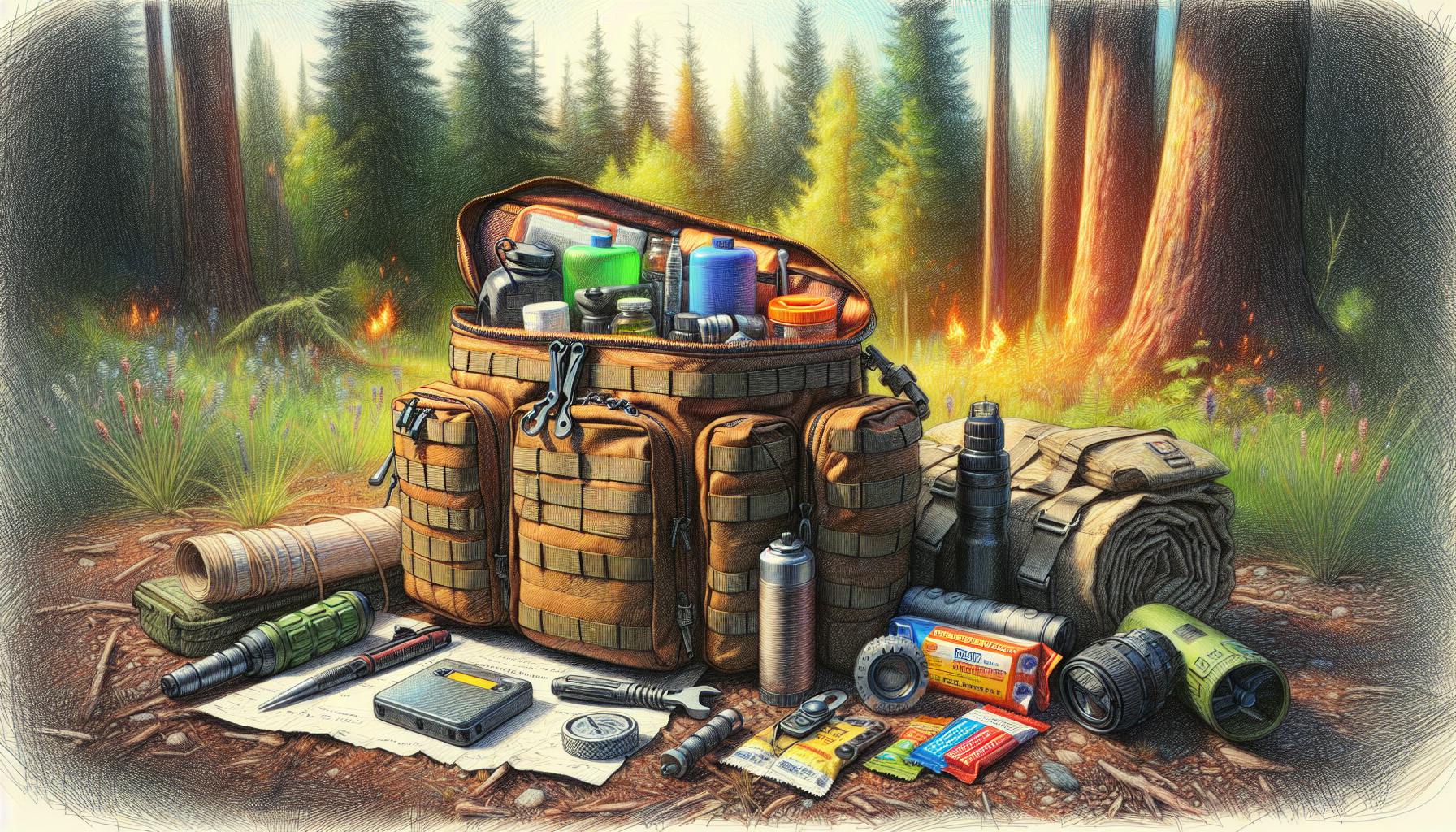When building an emergency kit, preppers know the value of versatile, packable gear. Most would agree that the bivy sack ticks those boxes.
With some key packing strategies, the humble bivy sack can transform into an indispensable shelter system for your bug out bag.
In this article, you'll discover pro techniques for packing your bivy sack efficiently, ensuring it integrates seamlessly with the rest of your gear. From space-saving folds to smart layering tactics, get ready to maximize your bivy's potential.
Unpacking the Bivy Sack Phenomenon
A bivy sack is a lightweight, minimalist shelter option popular among backpackers and preppers. As an ultralight alternative to tents, bivy sacks provide basic protection from the elements while prioritizing portability. This introductory section will define what a bivy sack is, explore the history behind its design, and outline key benefits that make it an ideal emergency shelter choice.
Exploring the Bivy Sack as a Survival Essential
A bivy sack, short for bivouac sack, is a thin, tapered shelter made of waterproof and breathable fabrics like Gore-Tex. Shaped like a tapered sleeping bag, a basic bivy sack fits one person snugly and protects from wind, rain, and snow. The top area is hooded to shield the head, while the bottom is left open for air circulation and freedom of movement. Bivy sacks provide just enough space to sleep in and store essentials. Their minimalist design makes them incredibly packable - some models pack down smaller than a 1L water bottle. This extreme lightness and portability makes the bivy an appealing shelter choice when every ounce matters.
A Brief History of the Bivy Sack
Bivy sacks trace their origins to alpine mountaineers carrying minimal gear for long climbs. Making shelters from tarps, plastic sheets, and waterproof fabrics kept weight low on multi-day ascents. In the 1990s and early 2000s, ultralight backpackers adopted similar minimalist shelters for thru-hikes when weight savings was paramount. Cottage gear makers began crafting specialized bivy sacks from advanced waterproof/breathable laminates. Today bivy sacks are a key component of fast-and-light survival kits where space is limited but reliable shelter is still essential.
Why Preppers Favor the Bivy Sack
For preppers building slimmed-down bug out bags, few pieces of gear provide as much utility per ounce as the bivy sack. Weighing as little as 8 oz packed, a bivy adds reliable foul weather protection without compromising precious pack space. Unlike tents, bivy sacks require no poles or setup; simply stake down the corners and crawl inside. Breathable fabrics prevent interior condensation buildup, while coated nylons block wind and precipitation. Used alone or integrated with a sleeping bag, bivy sacks create an adaptable shelter system ready for unpredictable scenarios. When planning for uncertain futures, the bivy sack's impressive strength-to-weight ratio makes it a sensible choice for survival-focused preppers.
What is the purpose of a bivy sack?
A bivy sack is a lightweight, minimalist shelter designed to protect a sleeping bag and provide additional protection from the elements for solo adventurers. Often made of waterproof and breathable fabrics like Gore-Tex, bivy sacks create a microclimate around your sleeping bag to shield you from rain, snow, and wind.
The main purposes of a bivy sack are:
- Provide basic shelter and warmth for ultralight backpacking where carrying a tent is impractical
- Waterproof and protect sleeping bag from moisture on wet ground or due to precipitation
- Retain body heat while sleeping to increase warmth on cold nights
- Camouflage sleeping area to remain hidden while cowboy camping
- Emergency shelter if stuck out overnight without proper gear
While more exposed than a tent, a bivy sack cuts down on weight and bulk substantially. With smart site selection and proper layering, a bivy sack can make ultralight hiking more feasible.
Is bivy bag worth it?
A bivy sack is an ultralight shelter designed to help protect your sleeping bag from the elements. Weighing only a few ounces, a bivy adds little weight while providing noticeable benefits.
Portability The main advantage of a bivy sack is its portability. Bivy sacks pack down incredibly small, some compressing to the size of a soda can. This makes them easy to strap to the outside of a backpack without taking up precious internal space. For minimalist hikers counting every ounce, a bivy is a worthwhile investment over bulkier shelter systems.
Weather Protection Made of waterproof and breathable materials, bivies shield sleep systems from precipitation and ground moisture. Many feature weather-resistant zippers and integrated bug netting for ventilation on clear nights. While less protective than a tent, a bivy sack gets the job done for short trips.
For ultralight backpackers prioritizing weight savings over absolute comfort, a bivy sack offers compelling advantages. Just be sure to pair it with a sleeping pad for insulation from the cold ground.
Do you need a sleeping bag inside bivy?
To use a bivi bag, put your sleeping bag and sleeping mat inside to protect you from the elements. Recently, the materials and fabrics have been improved to give the user a more lightweight and waterproof shelter.
Yes, you do need a sleeping bag inside your bivy sack. A bivy sack functions primarily as an outer shell for added shelter and protection from the elements, while the sleeping bag provides warmth and comfort.
Here are some reasons why you need a sleeping bag inside a bivy sack:
-
Insulation - A bivy sack is not insulated and cannot provide the necessary warmth on its own. The sleeping bag traps your body heat to keep you warm in cold conditions.
-
Comfort - A sleeping bag is designed for sleeping comfort with padded materials. The slim profile of a bivy sack lacks the comfort and cushioning of a sleeping bag.
-
Moisture control - While bivy sacks are waterproof on the outside, condensation buildup inside can make your sleeping bag damp if not properly ventilated.
-
Breathability - Bivy sacks minimize ventilation to block drafts, so a sleeping bag lets your skin breathe for more restful sleep.
-
Bio-break accessibility - When nature calls, a sleeping bag allows you to easily slip in/out of the bivy shelter without exposing you to the elements.
While a bivy sack adds essential shelter, pair it with a sleeping bag for insulation, breathability, comfort and easy bio-breaks at night. Choose a compact sleeping bag to maximize space.
sbb-itb-b932644
What is the point of a bivy tent?
A bivy sack is essentially a waterproof outer shell for your sleeping bag that provides basic shelter from the elements while maintaining an ultralight form factor. Bivy sacks are popular among solo adventurers like mountaineers, backpackers, and bikepackers who need to shave weight and space from their kits without fully sacrificing weather protection.
Some key benefits of using a bivy sack include:
-
Weight savings: Bivy sacks weigh just a few pounds at most, much less than even lightweight solo tents. This makes them ideal for fast and light trips.
-
Packability: When not in use, bivy sacks compress down very small to save precious space in your pack. Many are designed to pair perfectly with specific sleeping bags.
-
Water resistance: Made from waterproof and breathable fabrics, bivy sacks keep you and your sleeping bag protected from precipitation and wet ground. Most feature weather-resistant zippers and storm flaps as well.
So while bivy sacks do require some comfort tradeoffs compared to roomier tents, their ultra-compact and lightweight perks make them a popular shelter option for minimalist outdoor enthusiasts focused on moving efficiently. Whether climbing peaks or bikepacking cross-country, a bivy can pull double duty as shelter and stuff sack for gear-obsessed adventurers.
Choosing the Best Bivy Sack for Your Kit
Selecting the right bivy sack for your emergency kit involves balancing weather protection, weight and packability. The ideal bivy provides adequate shelter from the elements while adding minimal bulk to your pack.
Ensuring Optimal Weather Protection
The level of weather protection needed depends on your climate. Waterproof-breathable fabrics like Gore-Tex offer ventilation while blocking wind and rain. For extreme conditions, seek reinforced waterproof ratings of 10,000mm+ and full coverage. If condensation is a concern, consider a double-walled bivy.
Weighing Up Weight and Packability
As ultralight shelters, bivy sacks range from 8-32oz. Heavier models typically offer more weather resistance. Focus on compressible materials that pack small. The best balance of weight and protection depends on available space in your pack.
Prioritize weight for bug out bags. For vehicle kits, choose durable weather protection over compactness. Most standard kits can fit 1-2lb bivy sacks.
Accessories and Features: Enhancing Your Bivy Experience
Integrated pole supports provide structure for better ventilation. Waterproof stuff sacks protect your bivy when packed. Look for large zippers with storm flaps for easy access. A glow-in-the-dark zipper pull enables night ventilation adjustments.
While optional, bivy tent poles, stakes, repair kits and sleeping pad attachments bivy sack can improve shelter stability and comfort in challenging weather. Choose accessories that suit your likely emergency scenarios.
Strategies for Packing Your Bivy Sack Efficiently
Properly packing your bivy sack ensures it deploys quickly and functions as intended when needed. This section covers key folding techniques, compatible accessories, and tips for efficient storage within your emergency pack.
Folding Your Bivy Sack Like a Pro
When packing a bivy sack, it's important to fold or roll it neatly to maximize compression and minimize loose material that could snag when deploying in an emergency. Here are some recommended techniques:
The Ranger Roll
The Ranger Roll has long been a popular method used by military personnel to swiftly pack sleeping systems. To perform:
- Lay out your bivy sack flat with the inside facing up. Ensure zippers are fully closed.
- Tightly roll the bivy from the foot end toward the head end. Roll as tightly as possible.
- Secure the roll with straps or cords. Place neatly in your pack.
This technique evenly distributes bulk while compressing the material. It unrolls quickly when needed for shelter. Consider combining your bivy sack roll with a sleeping pad or bag using the next tip.
Sleep System Saddlebags
Get your bivy sack cozy with your sleeping bag by using the sleep system saddlebag method:
- With your bag laid out flat, place the bivy sack roll at one end.
- Begin rolling the sleeping bag around the bivy roll.
- Continue rolling evenly and securely until finished. Straps can lock the roll tight.
- This creates a cylindrical "saddlebag" shape with your sleep system neatly combined.
The result packs tightly while keeping items together. Unfurling it allows both the bivy and bag to be deployed rapidly.
Combining Your Bivy Sack with a Sleeping Bag
Pairing a bivy sack for sleeping bag usage ensures you get cushioning comfort and warmth along with the weather protection and insect shielding bivy sacks provide.
If your sleeping bag didn't come with a matching bivy sack, you can still reap the benefits of combining them. Just be mindful of the dimensions of each when putting together your sleep system.
Match Shapes
Mummy-shaped sleeping bags best match the tapered dimensions of most bivy sacks. Rectangular bags can still work but may have more dead space and loose material inside the bivy.
Get the Length Right
Make sure your sleeping bag's length matches the interior length of the bivy sack so your head and feet align properly at each end while inside.
Consider Insulation Needs
The extra layer created by the bivy sack can raise the temperature rating of the sleeping bag due to trapped body heat. So you may want to use a bag rated 5-10 degrees cooler than expected nighttime lows.
Accessorize: Expanding Bivy Shelter Capabilities
While a waterproof bivy sack on its own offers basic weather protection and shielding when used with a sleeping bag, you can expand its shelter capabilities by complementing it with accessories:
Add a Tarp Overhead
Pairing your bivy with a tarp creates an overhead shelter. It protects from falling rain or snow while also blocking ground moisture and splashback.
Insulate With a Closed-Cell Pad
A closed-cell foam sleeping pad helps insulate from cold ground. It also makes sleeping in your bivy more comfortable. Consider strapping it to the bottom of your bivy when packing them together.
Bring an Extra Blanket
Having a lightweight emergency blanket in your kit allows you to layer in additional warmth. Use it over your bivy sack if needed during extremely cold weather.
The right accessories can significantly improve shelter capability when combined properly with your bivy sack. Test different combinations during backyard trial runs to optimize your sleep system.
Maintaining Your Bivy Sack: Longevity Tips for Preppers
Like any piece of outdoor gear, proper care and maintenance is the key to ensuring your bivy sack is ready to perform when you need it most. This section will provide practical tips on cleaning, making repairs, and recommendations for storage to extend the lifetime of your bivy.
Effective Cleaning Techniques for Bivy Sack Longevity
Over time, bivy sacks can accumulate dirt, debris, and unpleasant odors that can degrade the materials. Here are some methods to clean your bivy based on the fabric type:
Silnylon: Mix a small amount of mild soap like Dr. Bronner’s in lukewarm water. Use a soft brush or sponge to gently clean the inside and outside. Rinse thoroughly with clean water and air dry out of direct sunlight.
Gore-Tex: Wash with a technical wash like Nikwax Tech Wash, following label instructions. Use a soft brush on stubborn stains. Hang to drip dry; avoid applying direct heat.
eVent: Wipe down with a soft, damp cloth and use a mild soap if needed. Do not machine wash. Allow to air dry fully before packing away.
Cleaning your bivy regularly after trips will lift dirt and salt that can abrade the fabric over time. Be sure no soap residue remains before storing.
DIY Repairs on the Field
Damage like small holes, broken zippers, or tears can compromise how well your bivy sack blocks wind and rain. Carry these supplies for emergency repairs:
- Silnylon patches
- Seam sealant like Gear Aid Sil Net
- Tenacious tape
- Zipper repair kit
- Extra guy line cord
First, clean the area thoroughly and allow to dry. Apply sealant to any mesh tears or holes, allowing it to cure. Adhere patches or tape over damaged fabric, pressing down firmly. Consult YouTube tutorials for fixes like zipper repairs and preventing runs in cord.
These quick fixes should restore waterproofing and structure until you can do more lasting repairs at home. Having the ability and supplies to mend vital gear is an invaluable prepping skill!
Storing Your Bivy Sack: Avoiding Material Fatigue
Leaving a tightly packed bivy squished down for a long time can over-stress the fabrics, decreasing technical performance. Here are some tips:
- Store in breathable bags; avoid airtight plastic bins. Use mesh laundry bags or pillowcases.
- Let the bivy fully air dry before packing away to prevent mold.
- If hanging, use wide, padded hangers to avoid creases over time.
- Limit compression; do not tightly roll or fold. Light packing helps materials rebound fully.
- Keep stored at moderate room temperatures; avoid hot attics or garages.
With some basic care between adventures, your trusty bivy sack will defend you from the elements for seasons upon seasons! Proper use, cleaning, repairs and storage helps maintain waterproofness, breathability and livability.
Real-World Applications: Maximizing Bivy Sack Potential
This concluding section covers real-world bivy sack usage tips from experienced preppers and survivalists. Learn how others integrate bivy sacks effectively into their packs and emergency plans.
Choosing Your Bivy Site Wisely
When setting up your bivy sack, consider terrain, exposure, and proximity to hazards.
- Seek natural shelters like thickets or rock outcroppings to block wind and precipitation. A bivy sack alone provides minimal insulation.
- Avoid creek beds or low points that can flood.
- Stay clear of dead trees or branches that may fall in high winds.
- If camping in snow, dig a trench under your sack to protect from conductive heat loss.
With careful site selection, a bivy sack can safely sustain you through a night in the elements.
Prepping for Extended Use: Expert Advice
For stays over 24 hours, our experts recommend:
- Pack additional thermal insulation like a sleeping pad or closed-cell foam. Bivy sacks lack padding.
- Bring supplemental shelter like a tarp for rainfall or sun protection.
- Prepare food, water, medications for the duration.
- Choose durable, waterproof sacks with reinforced fabric.
- Test and seal any minor leaks with repair tape before relying on long-term.
With the right backup gear and preparation, bivy sacks can bridge the gap for several days if needed.
Survival Stories: The Bivy Sack in Action
Caught in a heavy downpour on a backpacking trip, Susan took refuge under a bivy sack overnight: "My sleeping bag stayed dry thanks to the waterproof floor. But sides were mesh, so I got wet. Wished I had a tarp overhead." She stayed warm enough with hot tea and thermal layers until the storm passed. "Worked fine overnight, but wouldn't want to rely on it longer."
When their camper window broke in a hailstorm, the James family used bivy sacks as a temporary fix. "The heavy-duty, vinyl sack kept the rain out. But with four of us packed inside, it got pretty humid and sweaty! Glad it was just for one night." With proper backup gear like ventilation and bedding, they could have used the bivy shelters for several days.


